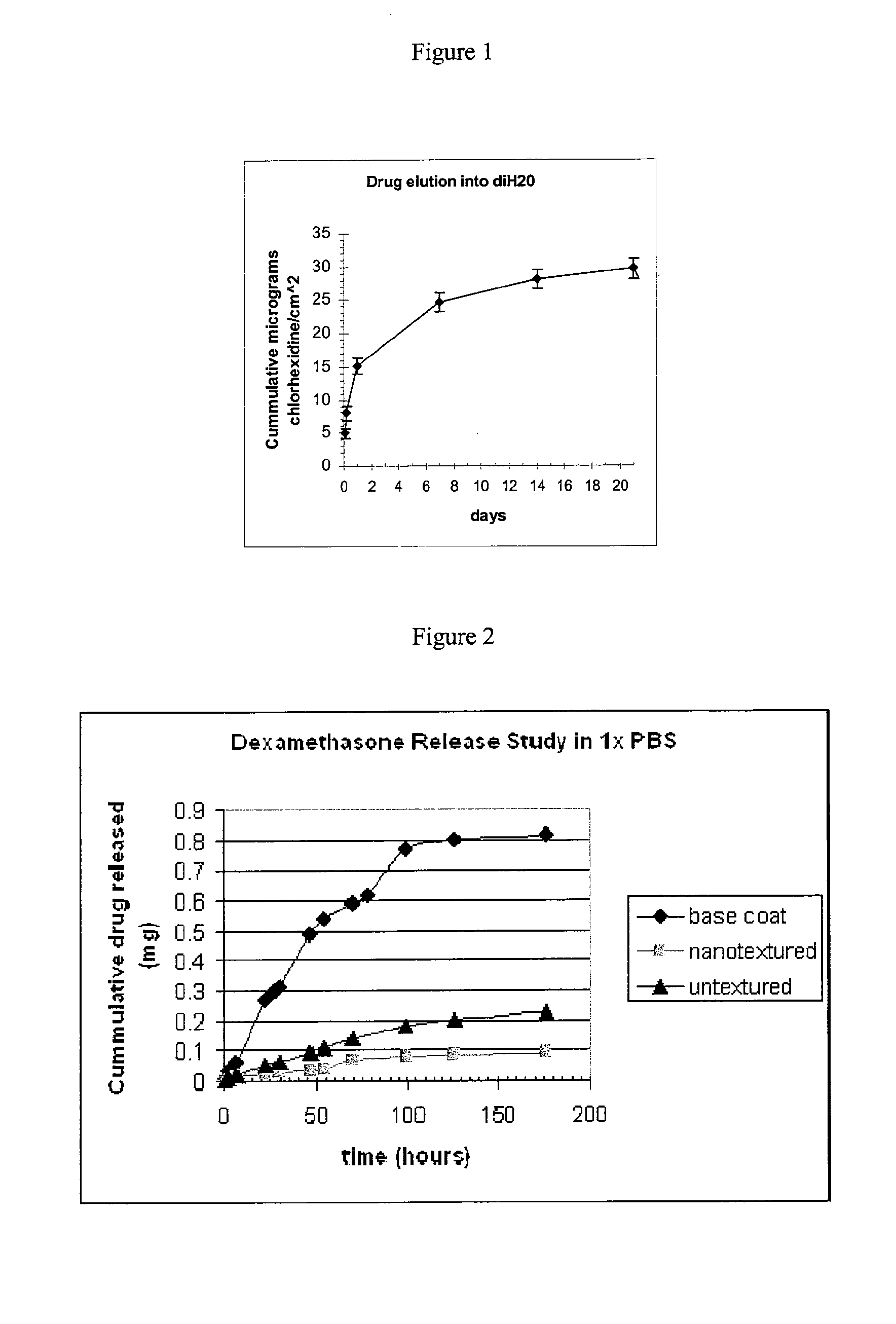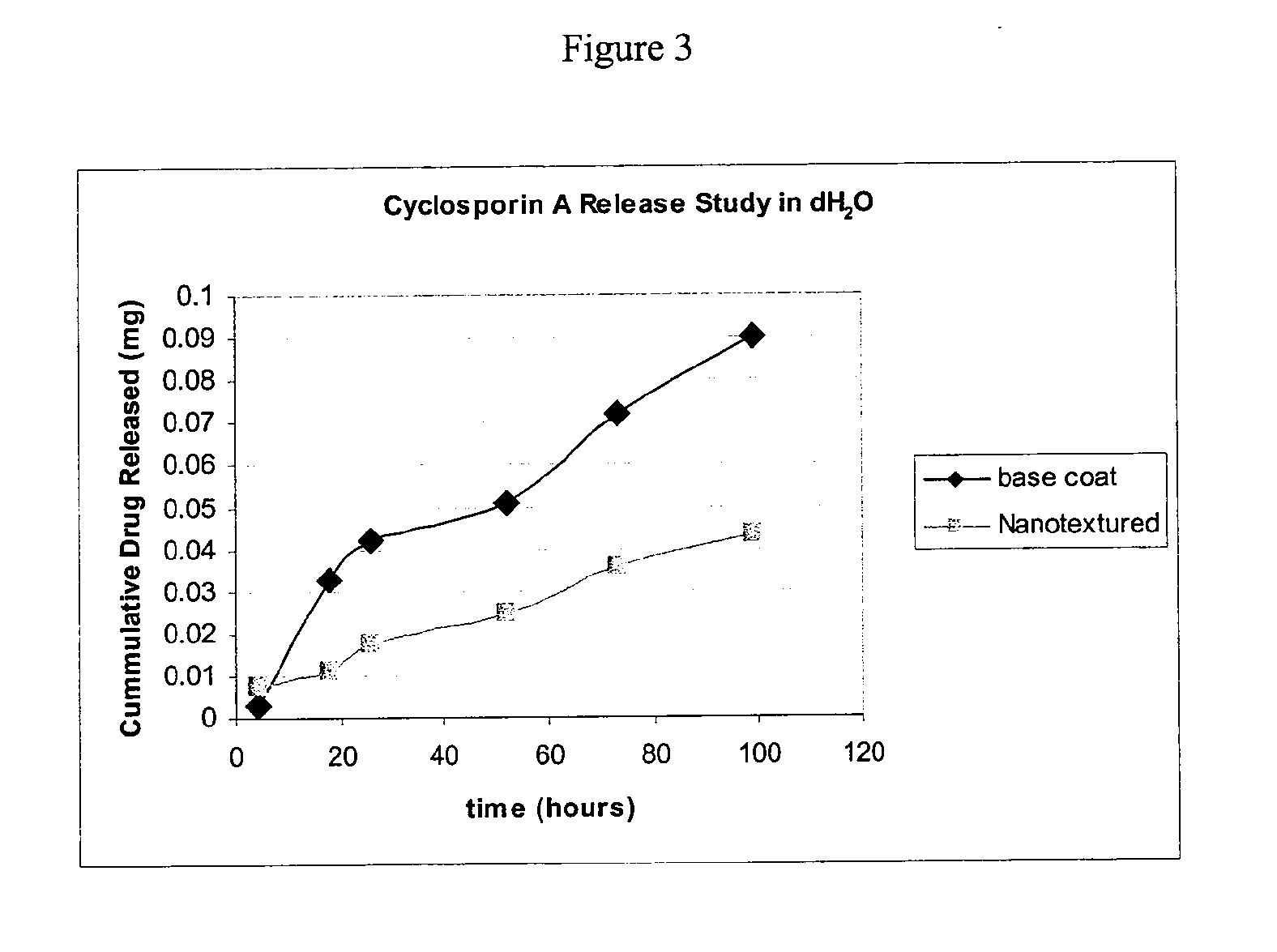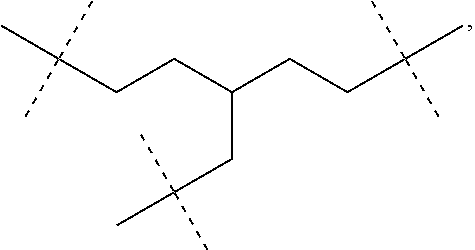Drug eluting superhydrophobic coatings
a superhydrophobic coating and drug technology, applied in the direction of prosthesis, drug composition, catheter, etc., can solve the problems of many lives, billions of dollars in cost, waste of resources,
- Summary
- Abstract
- Description
- Claims
- Application Information
AI Technical Summary
Benefits of technology
Problems solved by technology
Method used
Image
Examples
example 1
Photocrosslinker A Synthesis
[0304]1.2 g (4 mmol) of triglycidyl isocyanurate (Aldrich Chemicals, Milwaukee, Wis.) and 2.4 g (12 mmol) of 4-hydroxybenzophenone (Aldrich Chemicals, Milwaukee, Wis.) were mixed in a 50-ml round bottom flask containing a magnetic stir bar. The flask was flushed with argon for 10 min and heated to 130° C. in an oil bath. Once the reaction mixture melted, 6 mg (0.02 mmol) of triphenylphosphine (Aldrich Chemicals, Milwaukee, Wis.) was added. The mixture was stirred for another 2 minutes under argon and cooled to room temperature. The reaction residue was dissolved in 30 ml chloroform, then washed with 4N NaOH (30 ml×3) and deionized water (30 ml×3). The organic layer was dried over magnesium sulfate and concentrated to dryness on the under reduced pressure. The product was purified by column chromatography (silica gel, 230-400 mesh, Whatman, Inc.) using ethyl acetate as eluent (Rf˜4.5). The fractions containing the pure product were combined and concentrate...
example 2
Chlorhexidine Elution into Deionized Water from a Superhydrophobic Sample
[0306]Sample Preparation
[0307]PVC slides (Rinzl brand, VWR, Batavia, Ill., 0.5 mm thick) were cut into 55×12 mm sections, cleaned with IPA, and dried overnight in a vacuum oven (40° C.). A basecoat solution, containing 14 mg / ml chlorhexidine (Sigma Aldrich, St. Louis, Mich.) and 20 mg / ml polycaprolactone, PCL, (˜80K g / mol) (Aldrich Chemical Co. Milwaukee, Wis.) dissolved in methyl acetate, was applied to the slides by a dipcoat method. The slides were dipped into the basecoat solution and after a 30 sec dwell, the slides were withdrawn at a rate 5 cm / sec. The coated slides were air dried and then dried overnight in a vacuum oven (40° C.). The samples were weighed prior to application of the basecoat, and reweighed following oven drying of the basecoat. A superhydrophobic surface coating was then applied to the sample, covering the chlorhexidine / polycaprolactone basecoat. The superhydrophobic topcoat solution co...
example 3
Microbial Zone of Inhibition for Superhydrophobic / Drug Eluting Surfaces
[0311]Two superhydrophobic coated polyvinyl slides containing chlorhexidine were prepared as described in example 1, except that the topcoat contained 20 mg / mL PCL, 24 mg / mL LE3 particles and 0.8 mg / mL Photocrosslinker A, and it was dissolved in methyl acetate instead of tetrahydrofuran. One coated slide was stored dry in an amber capped vial and the second coated slide underwent the bioactive agent release assay for 14 days as described in example 1. After 14 days, the coated slide was dried in vacuum oven at 40° C. overnight.
[0312]A 1.8 mL suspension of Staphylococcus aureus ATCC#6538 (Microbiologics, St. Cloud Minn.) (approximately 108CFU / mL which corresponds to a McFarland Nephelometer 0.5) was prepared in 1×PBS using a sterile swab, a small borosilicate test tube (12×75 mm), and a Vitek colorimeter. In order to ensure that the coatings were neither over challenged nor under challenged, inoculum counts were p...
PUM
| Property | Measurement | Unit |
|---|---|---|
| size | aaaaa | aaaaa |
| surface tension | aaaaa | aaaaa |
| surface tension | aaaaa | aaaaa |
Abstract
Description
Claims
Application Information
 Login to View More
Login to View More - R&D
- Intellectual Property
- Life Sciences
- Materials
- Tech Scout
- Unparalleled Data Quality
- Higher Quality Content
- 60% Fewer Hallucinations
Browse by: Latest US Patents, China's latest patents, Technical Efficacy Thesaurus, Application Domain, Technology Topic, Popular Technical Reports.
© 2025 PatSnap. All rights reserved.Legal|Privacy policy|Modern Slavery Act Transparency Statement|Sitemap|About US| Contact US: help@patsnap.com



